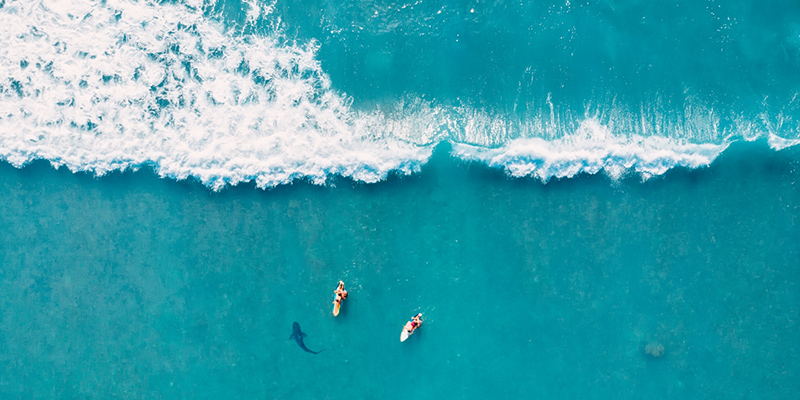Surfers share their waves with sharks, but fear not
By Dr Brianna Le Busque
 SOCIETY AND CULTURE
SOCIETY AND CULTURESurfers have a complex relationship with sharks. Many surfers, either knowingly or not, share their waves with sharks of various shapes and sizes. On rare occasions these interactions can result in bites or close calls.
A highly publicised close call involved Australian surfer Mick Fanning and a white shark during the 2015 World Surf League final at Jeffreys Bay in South Africa. A video of this interaction has more than 19 million views on YouTube alone. Others tune into Hollywood films such as Soul Surfer, which tells the story of surfer Bethany Hamilton, who lost her arm to a tiger shark in Hawaii.
Shark bites on humans are rare. Worldwide, there were 112 confirmed bites in 2021 on the International Shark Attack File, with nine unprovoked bites resulting in fatalities. When shark bites occur, often surfers are involved because they are frequently in the ocean. Despite this, many surfers appear to accept these interactions as simply a part of surfing.
Surfers even refer to certain sharks as “locals” at particular breaks. In many places, surfers use the term “men in grey suits” when sharks are present. Authors of a 2019 study in California explain this euphemism is used to alert surfers that sharks are present without causing anxiety or stress.
A new study published in Marine Policy surveyed 391 surfers across 24 different countries (predominantly the United States). The study found 60% of surfers are not afraid of sharks despite 52% having seen sharks while surfing. And 17% said either they or someone they knew had been bitten by a shark.
Why aren’t surfers afraid?
This study of the complex but little-researched relationship between surfers and sharks offers interesting insight into the perception of risk.
In general, most people have no direct experience with sharks, yet overestimate the chance of encountering one and have a strong fear of them. Many surfers have had direct encounters with sharks but perceive the risk to be low and aren’t afraid of them. In fact, 44% of surfers said they would still go into the water if a shark was sighted.
The psychology of cognitive heuristics – or shortcuts in thinking – can help us explain why surfers aren’t afraid of sharks.
The behavioural psychology principle of operant conditioning explains how consequences influence behaviours. For surfers who have encountered a shark but have not been bitten or had a close call, this behaviour of surfing with sharks (and not being afraid) is being reinforced.
Perhaps this lower level of fear is influenced by a consistent personality trait. Research has found people high in sensation-seeking, which is the tendency for people to pursue thrill-seeking experiences, view the risks of sharks as lower. It is plausible that many surfers are high on sensation-seeking, which may help explain why they perceive the risk of sharks to be low.
Post-rationalisation, or choice-support bias, is the tendency for people to ascribe positive attributes to a decision they have made, essentially to justify the decision. Surfers may downplay their fear of sharks to rationalise their decision to continue to surf, as their desire to surf is greater than their perceived risk of a shark bite.
How does this affect shark conservation?
Globally, it’s estimated humans kill 100 million sharks each year. A quarter of all shark species are now threatened with extinction, so actions to protect them are important.
Given the general public’s fear of sharks is a barrier to shark conservation, understanding surfers’ shark fears (or lack thereof) gives us an important insight into fear and perception of risk. This will further our understanding of these complicated psychological factors.
In the discussion of shark conservation, the many relevant groups include politicians, fishers, the media and scientists. But frequent ocean users such as surfers are often overlooked, despite being more likely to interact with sharks than others.
Giving this cohort a weighted voice in the discussion of shark management and reducing the risks of shark bite will ensure a better, more logical balance between safety and conservation.
This article is republished from The Conversation under a Creative Commons licence. Read the original article.
Other Stories
- Vitamin D deficiency linked to premature death
- Surfers share their waves with sharks, but fear not
- Sand serves up a possible cure for obesity
- Rising from the ashes: positive life changes emerge after black summer of bushfires
- From the Vice Chancellor
- Achievements and Announcements November 2022
- An experience to eclipse all others: The Adelaide Planetarium, 50 years on
- Star-studded line-up for UniSA graduates
- Child protection: breaking the cycle of harm
- UniSA launches Global Executive MBA in Defence and Space
- The latest books from UniSA researchers November 2022
- In Pictures: Hon docs and Samstag premiere of Hello Dankness




